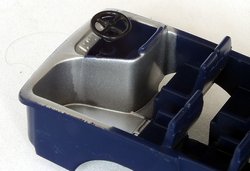This certainly makes adding extra detailing or passengers to the interior of model extremely easy, those contemplating repainting however will be limited somewhat by the one piece plastic body, which will need careful masking to protect the glazed areas.
 The interior component is made of plastic, interestingly Oxford have painted the floor around the entrance and cab area silver. One slightly strange detail is the interior mould has a section blocking the lower part of the entrance which blocks off the lower door glazing.
The interior component is made of plastic, interestingly Oxford have painted the floor around the entrance and cab area silver. One slightly strange detail is the interior mould has a section blocking the lower part of the entrance which blocks off the lower door glazing.
All in all another impressive model from Oxford, for the price, around £16 in the UK, this is good value for money. There are some problems as noted above, but most of these are either minor or probably fixable on future releases.
A full list of the 1/76 scale releases to date can be found HERE.



